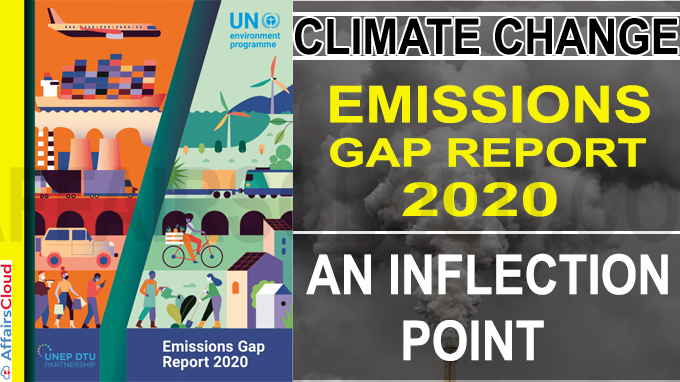 According to 11th Edition of Emissions Gap Report 2020 (Annual report) released by United Nations Environment Programme (UNEP), The Global CO2 (Carbon Dioxide) Emissions are set to fall by 7% in 2020 owing to Pandemic. The report states that emissions of the richest 1% of the Global Population (Countries like United States of America (USA), European Union (EU), Australia and New Zealand) account for more than twice of the share of poorest 50% of countries.
According to 11th Edition of Emissions Gap Report 2020 (Annual report) released by United Nations Environment Programme (UNEP), The Global CO2 (Carbon Dioxide) Emissions are set to fall by 7% in 2020 owing to Pandemic. The report states that emissions of the richest 1% of the Global Population (Countries like United States of America (USA), European Union (EU), Australia and New Zealand) account for more than twice of the share of poorest 50% of countries.
Key Points:
i.Global GreenHouse Gas (GHG) emissions continued to rise in 2019. 52.4 GtCO2e (Gigatonnes of equivalent carbon dioxide) without land-use change (LUC) and 59.1 GtCO2e including LUC.
ii.During the last decade (2010-20) the top four emitters (China, USA, EU 27+United Kingdom and India) contributed to 55% of Total GHG emission without LUC.
iii.The emission reduction due to COVID-19 accounts for just 0.01 Degree Celsius Reduction of Global Warming by 2050.
iv.Although CO2 emissions are slated to decrease in 2020, Atmospheric concentrations of major GHGs (CO2, methane & Nitrous oxide) continued to increase in 2019 & 2020.
v.The report also stated that 2020 could be the warmest on record, with wildlife, storms and droughts affecting the world.
Sectors contributing most to Global CO2 emissions:
Sectors such as Shipping (Domestic & International) and Aviation account for 5% of Global CO2 emissions. Shipping accounts for 71% and Aviation accounts for 65% of Global CO2 emissions.
Green Pandemic Recovery:
Green Pandemic Recovery will bring 2030 emissions close to achieve the goal of reducing Global Temperature by 2 Degrees, with more needed for a 1.5 Degree Celsius Goal.
Net-Zero Goals:
Globally 126 countries covering 51% of Global GHG emission have announced Net-Zero goals.
Annual Emission Targets:
To Achieve the reduction of Global temperature of 2-Degree Celsius by 2030 the annual emission needs to be 15 GtCO2e lower than current unconditional NDCs (Nationally Determined Contributions), 32 GtCO2e lower for 1.5 Degree Celsius Goal.
Regarding India:
i.India is responsible for 7.1 % of Global Emission and has per capita emission which is 60% lower than Global average.
ii.It highlighted the initiative of Delhi Government to increase Electric vehicles to 25% of new vehicle registration 2024.
iii.India stands Fourth in terms of overall emission (3.7 GtCO2e) in 2019. The top 3 countries are China, USA, and EU+UK.
Measures adopted by India to address Emissions:
The report highlighted initiatives taken by India to reduce emission
i.India has not built any new coal-fired power plants in the first half of 2020 due to which India’s Coal capacity decreased by 0.3 GigaWatts (GW).
ii.India has introduced PM-KUSUM Scheme (Pradhan Mantri-Kisan Urja Suraksha evam Utthan) to develop 25 GW of capacity by 2022 through expansion of solar investments in its agriculture sector.
iii.Launch of 2nd phase of Faster Adoption and Manufacturing of Electric Vehicles (FAME II) project to support Electric Vehicle (EV) purchases and charging infrastructure.
iv.Mission of Indian Railways (IR) to completely electrify the rail-network by 2023, IR announced its plans to achieve net-zero emissions by 2030.
Recent Related News:
i.September 22, 2020, In accordance with the study “Ice Sheet Model Intercomparison Project (ISMIP6)” by NASA’s Goddard Space Flight Center in Greenbelt, Maryland (United States) there will be more than 38 centimetres (15 inches) rise in global sea-level rise by 2100
ii.On November 4, 2020 the United States (US) became the first country to formally exit the Paris Climate Agreement.
About United Nations Environment Programme (UNEP):
Executive Director – Inger Andersen
Headquarters – Nairobi, Kenya




